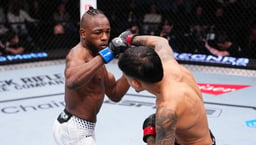
Issue 156
July 2017
Why you should get flexible for success on the ground
Whenever a mixed martial artist thinks outside the box and does something improvisational, inventive and inspired, it usually triggers a raucous response from the nosebleeds. It could be flashy, it could be functional – but it’s usually guaranteed to force a reaction. The rubber guard is one of those things.
Whether it’s for show or survival, the rubber guard is an eye-catching part of the jiu-jitsu canon. Furthermore, though it’s rare, it gets results. “It’s very effective,” says George Sotiropoulos, a staunch advocate. “It’s a piece of the puzzle I noticed was missing in a lot of MMA fights.
“When I saw Shinya Aoki using the rubber guard, I realized I wanted to learn it. I first saw Eddie Bravo using this technique in 2001 when I attended Jean Jacques Machado’s academy in Los Angeles. He was still in the formative stages of his jiu-jitsu career, but it looked very unorthodox and that appealed to me.”
The Aussie put it to great use during a run that took him on a charge towards the top of the UFC lightweight division, not least when he was the local hero at the UFC’s first show Down Under. Sotiropoulos had a sold-out crowd on its feet as he used his flexibility to fight Joe Stevenson from his back. The noise increased as he trapped him, threatened submissions, set up strikes and swept ‘Daddy’. It was a dominant performance, despite his status as an underdog.
“Nobody can say the rubber guard isn’t effective. I’ve used it, others have used it. There’s no disputing it’s worth. But it has to be used properly.”
According to George Sotiropoulos...
How to use the rubber guard effectively
Get flexible
“It’s hard to learn because it requires a degree of flexibility, but developing flexibility is as easy as developing technique, strength, speed or stamina. you just have to work on it. It’s like anything. If you want to improve your writing skills, go write. If you want to improve your speaking skills, go speak. Flexibility is no different.”
Accept it’s low-percentage
“Why doesn’t everybody do it? Against an experienced opponent who knows how to posture, it can be neutralized. But, if you know how to use it, it’s actually a safe move. If you’re on the bottom and someone is in your guard, the rubber guard is an excellent option for locking them up and controlling them, especially if you can’t do that with any other basic clinch, such as an overhook or a neck-tie.”
Have your foundations in place
“The reason I was very successful at showcasing the rubber guard was because I had an entire foundation of jiu-jitsu to sustain and support it. If my guard attempts failed, I had a closed guard, a half guard and an open guard. I had my own escapes and submissions. I had guard recovery techniques. Without those foundations, it’s not really applicable and it’s more of an add-on technique. You can’t just work that one guard and use it as your go-to option. That’s like going into a fight saying you’re going to only throw a left hook.”
Gain control from the bottom
“I could identify its potential in a situation where you’re fighting a wrestler with a very good top game and they’re on top. That’s where I was able to use it effectively against Kurt Pellegrino and Joe Stevenson. There’s a misconception that BJJ guys want to be on the bottom because Royce Gracie submitted his opponents in the early UFC events with guard techniques. But he didn’t voluntarily put himself there: he went there because he was smaller, they were stronger and they put him there. He then used what was at his disposal.”










